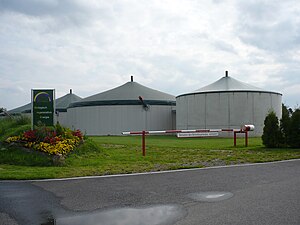 Image via Wikipedia
Image via WikipediaAnaerobic digestion provides a variety of benefits. These may be classified into three groups viz. environmental, economic and energy benefits:
The environmental benefits include:
a) Elimination of malodorous compounds.
b) Reduction of pathogens.
c) Deactivation of weed seeds.
d) Production of sanitized compost.
e) Decrease in GHGs emission.
f) Reduced dependence on inorganic fertilizers by capture and reuse of nutrients.
g) Promotion of carbon sequestration
h) Beneficial reuse of recycled water
i) Protection of groundwater and surface water resources.
j) Improved social acceptance
Anaerobic digestion is advantageous in terms of energy generation in the following manner:
a) Anaerobic digestion is a net energy-producing process.
b) A biogas facility generates high-quality renewable fuel.
c) Surplus energy as electricity and heat is produced during anaerobic digestion of biomass.
d) Anaerobic digestion reduces reliance on energy imports.
e) Such a facility contributes to decentralized, distributed power systems.
f) Biogas is a rich source of electricity, heat, and transportation fuel.
The economic benefits associated with a biogas facility are:
a) Anaerobic digestion transforms waste liabilities into new profit centers.
b) The time devoted to moving, handling and processing manure is minimized.
c) Anaerobic digestion adds value to negative value feedstock.
d) Income can be obtained from the processing of waste (tipping fees), sale of organic fertilizer, carbon credits and sale of power.
e) Power tax credits may be obtained from each kWh of power produced.
f) A biomass-to-biogas facility reduces water consumption.
g) It reduces dependence on energy imports.
h) Anaerobic digestion plants increases self-sufficiency.
